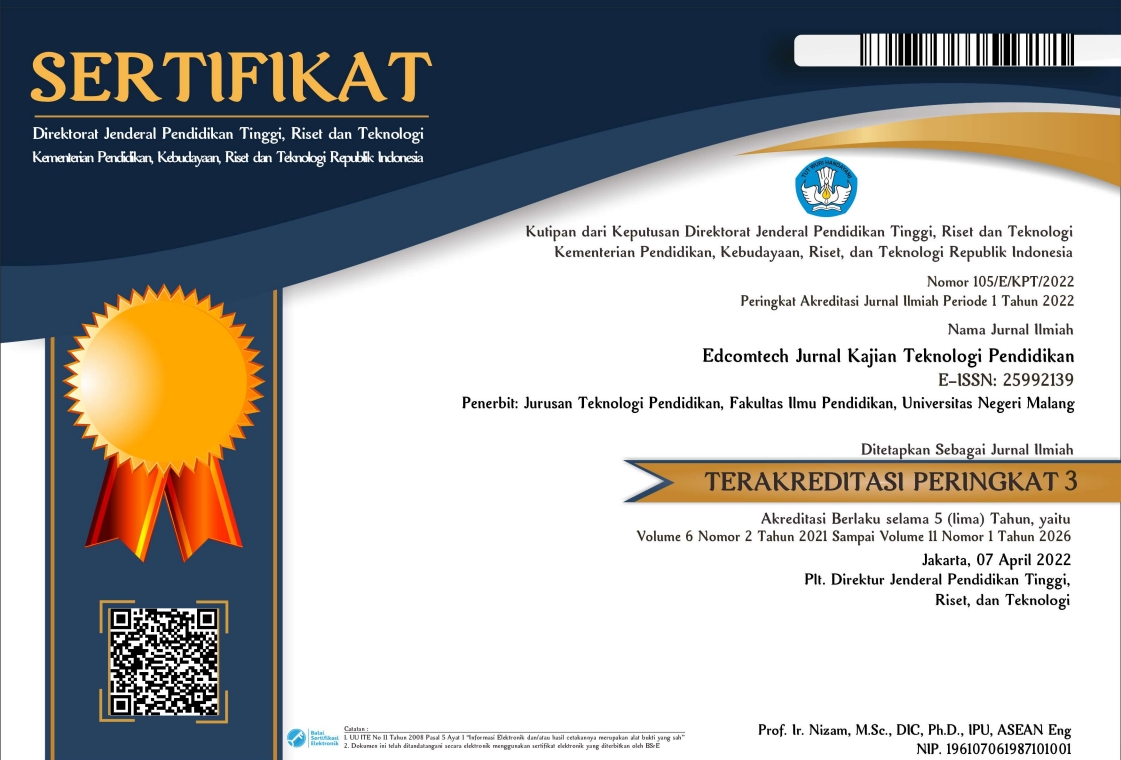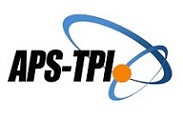Instagram: From Media Sharing Network To Learning Resource (Studi Terhadap Dua Akun Instagram)
Abstract
Abstrak: Sosial media dapat memudahkan seseorang dalam berkomunikasi secara satu arah maupun dua arah dan kemudian secara kolaboratif membangun suatu sistem yang berbasis pengetahuan dan membentuk suatu komunitas belajar virtual. Penelitian ini bermaksud untuk melakukan investigasi terhadap penggunaan sosial media khususnya Instagram sebagai sumber belajar informal dengan melihat hubungan pemanfaatan fitur Instagram dengan keterlibatan belajar penggunanya. Penelitian ini dilakukan dengan memberikan kuesioner pada masing – masing pengikut dua akun Instagram yang akan diteliti. Berdasarkan hasil pengukuran keterlibatan belajar dengan menggunakan alat ukur engaging learning environment, ditemukan bahwa terdapat hubungan positif yang kuat dan signifikan antara persepsi pemanfaatan fitur instagram dengan keterlibatan belajar dengan besar kekuatan hubungan 27,4%. Interaksi merupakan indikator yang memiliki hubungan paling kuat dengan keterlibatan belajar. Fitur Instagram live merupakan fitur Instagram yang memiliki hubungan positif dan terkuat diantara fitur Instagram lainnya.
Abstract: Social media or social networking sites can easily enable people to communicate in synchronous or asynchronous way and then collaboratively built a knowledge-based system and form a virtual learning community. This study aimed to investigate the application of a social media, especially Instagram as an informal learning resource by reviewing the relationship between Instagram features utilization and the learning engagement of the followers. This research was conducted by giving questionnaire to each of the two Instagram account to be examined. Based on the result of the measurement of learning engagement, using the engaging learning environment measurement tools, it was found that there was a strong and significant relationship between them with a relationship strength of 27.4%. Interaction is the indicator that has the strongest relationship with learning engagement, and Instagram live feature has the strongest positive relationship among other Instagram features. Thus, Instagram could be said as an engaging learning environment.
Keywords
Full Text:
PDFReferences
Asio, S. M., & Khorasani, S. T. (2015). Social media: A platform for innovation. In IIE Annual Conference. Proceedings (p. 1496). Institute of Industrial and Systems Engineers (IISE).
Berg, S. A., & Chyung, S. Y. (2008). Factors that influence informal learning in the workplace. Journal of workplace learning, 20(4), 229-244.
Boon, H. J. (2008). Risk or resilience? What makes a difference?. The Australian Educational Researcher, 35(1), 81-102.
Boyd, D. M. (2008). ELLISON. Nicole B. Social Network Sites: definition, history and scholarship. Journal of Computer-Mediatied Communication, (13), 210-230.
Carr, D. (2003). Making sense of education: an introduction to the philosophy and theory of education and teaching. London: RoutledgeFalmer.
Cavanagh, M. (2011). Students’ experiences of active engagement through cooperative learning activities in lectures. Active Learning in Higher Education, 12(1), 23-33.
Cavanagh, R. F. (2015). A unified model of student engagement in classroom learning and classroom learning environment: one measure and one underlying construct. Learning Environments Research, 18(3), 349-361.
Cavanagh, R., Kennish, P., & Sturgess, K. (2008). Develpment of a theoretical framework to inform measurement of secondary school student engagement with learning. In Changing Climates: Education for Sustainable Futures, 2008 Annual Conference of the Australian Association for Research in Education. AARE.
Cohen, B. (2011). Basic Smart city Indicators: Smart city Wheel. Diakses dari https://www.smart-circle.org/smartcity/blog/boyd-cohen-the-smart-citywheel/ (17 Oktober 2019).
Cross, J. (2011). Informal learning: Rediscovering the natural pathways that inspire innovation and performance. John Wiley & Sons.
Dabbagh, N., & Kitsantas, A. (2012). Personal Learning Environments, social media, and self-regulated learning: A natural formula for connecting formal and informal learning. The Internet and higher education, 15(1), 3-8.
Diemer, T. T., Fernandez, E., & Streepey, J. W. (2012). Student perceptions of classroom engagement and learning using iPads. Journal of Teaching and Learning with Technology, 13-25.
Drachsler, H., Hummel, H., & Koper, R. (2008). Identifying the goal, user model and conditions of recommender systems for formal and informal learning.
Fredricks, J. A., Blumenfeld, P. C., & Paris, A. H. (2004). School engagement: Potential of the concept, state of the evidence. Review of educational research, 74(1), 59-109.
Friesen, N., & Anderson, T. (2004). Interaction for lifelong learning. British Journal of Educational Technology, 35(6), 679-687.
Handayani, F. (2015). INSTAGRAM AS A TEACHING TOOL? REALLY?. Proceedings of ISELT FBS Universitas Negeri Padang, 4(1), 320-327.
Harrison, C., & Donnelly, I. A. (2011, September). A theory of smart cities. In Proceedings of the 55th Annual Meeting of the ISSS-2011, Hull, UK (Vol. 55, No. 1).
Hilton, J. (2009). Essential versus strategic IT investments. Educause review, 44(4), 8-9.
Kabilan, M. K., Ahmad, N., & Abidin, M. J. Z. (2010). Facebook: An online environment for learning of English in institutions of higher education?. The Internet and higher education, 13(4), 179-187.
Koper, R. (2004). Use of the Semantic Web to Solve Some Basic Problems in Education: Increase flexible, distributed lifelong learning; decrease teacher's workload. Journal of Interactive Media in Education, 2004(1).
Leung, R., Schuckert, M., & Yeung, E. (2013). Attracting user social media engagement: A study of three budget airlines Facebook pages. In Information and communication technologies in tourism 2013 (pp. 195-206). Springer, Berlin, Heidelberg.
Lido, C., Osborne, M., Livingston, M., Thakuriah, P., & Sila-Nowicka, K. (2016). Older learning engagement in the modern city. International Journal of Lifelong Education, 35(5), 490-508.
Liu, Y. (2010). Social media tools as a learning resource. Journal of Educational Technology Development and Exchange (JETDE), 3(1), 8.
Marjoribanks, K. (2006). Adolescents’ cognitive habitus, learning environments, affective outcomes of schooling, and young adults’ educational attainment. Educational Psychology, 26(2), 229-250.
Moore, M. G., & Keegan, D. (1993). Theoretical principles of distance education. Theoretical principles of distance education, 22-39.
Raacke, J., & Bonds-Raacke, J. (2008). MySpace and Facebook: Applying the uses and gratifications theory to exploring friend-networking sites. Cyberpsychology & behavior, 11(2), 169-174.
Raacke, J., & Bonds-Raacke, J. (2015). Are students really connected? Predicting college adjustment from social network usage. Educational Psychology, 35(7), 819-834.
Selwyn, N. (2007). The use of computer technology in university teaching and learning: a critical perspective. Journal of computer assisted learning, 23(2), 83-94.
Vygotsky, L. S. (1978). Mind in society (M. Cole, V. John-Steiner, S. Scribner, & E. Souberman, Eds.).
Wang, Q., Woo, H. L., Quek, C. L., Yang, Y., & Liu, M. (2012). Using the Facebook group as a learning management system: An exploratory study. British Journal of Educational Technology, 43(3), 428-438.
Yadegarfar, H., & Simin, S. (2016). Effects of using Instagram on learning grammatical accuracy of word classes among Iranian undergraduate TEFL students. International journal of research studies in educational technology, 5(2).
Zanella, A., Bui, N., Castellani, A., Vangelista, L., & Zorzi, M. (2014). Internet of things for smart cities. IEEE Internet of Things journal, 1(1), 22-32.
Zhang, K., & Gao, F. (2014). Social media for informal science learning in China: A case study. Knowledge Management & E-Learning: An International Journal, 6(3), 262-280.
Zhu, E. (2006). Interaction and cognitive engagement: An analysis of four asynchronous online discussions. Instructional Science, 34(6), 451.
DOI: http://dx.doi.org/10.17977/um039v5i12020p097
Refbacks
- There are currently no refbacks.
Copyright (c) 2020 Sakina Rahmania, Bagus Takwin

This work is licensed under a Creative Commons Attribution-ShareAlike 4.0 International License.
Edcomtech: Jurnal Kajian Teknologi Pendidikan published by Department of Educational Technology, Faculty of Education, State University of Malang in Collaboration with Asosiasi Program Studi Teknologi Pendidikan Indonesia (APS TPI) and Ikatan Profesi Teknologi Pendidikan Indonesia (IPTPI) with MoU.
Publisher Address:
Lab. Teknologi Pendidikan, Gd.E2, Lt.1
Fakultas Ilmu Pendidikan Universitas Negeri Malang
Jalan Semarang No 5, Kota Malang Kode Pos 65145
Email: edcomtech.fip@um.ac.id
========================================================================================================
| INDEXED BY | TOOLS | PLAGIARISM CHECK | ARTICLE TEMPLATE |
|

Edcomtech is licensed under a Creative Commons Attribution-ShareAlike 4.0 International License.
Edcomtech Statistics (Since July 13th, 2020)











1.png)








